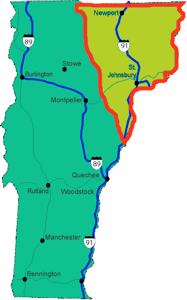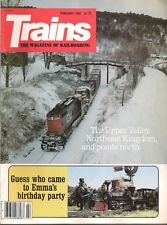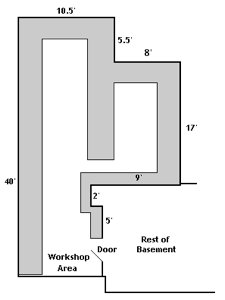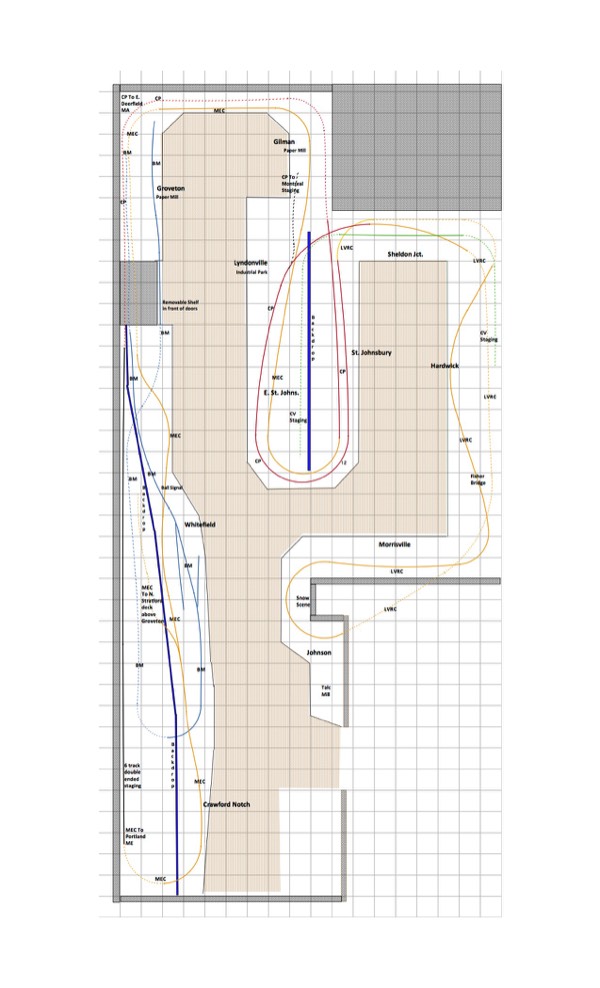Menu
My Layout
My first task was to prepare the layout area with walls, ceiling, electrical and lighting. I also created a doorway from the rest of the basement so I can lock up the layout room when not in use. After a few months of work, that was finally complete and I was ready to start building the layout in early 2003.
Name: Northeast Kingdom
Scale: HO (1:87.1)
Size: 19' x 40' overall
Theme: Interchange yard operations with through and local freights, Class I and shortlines
Roads: Maine Central, Lamoille Valley, Canadian Pacific, Boston & Maine, Central Vermont, North Stratford Railroad Company
Locales: St. Johnsbury VT, northern Vermont and northern New Hampshire
Era: 1980
Layout Style: Around the walls with center peninsula
Layout Heights: 48" to 55"
Benchwork: L girder
Subroadbed: Wood Spline, Plywood
Roadbed: Homa-Bed, Homasote, some Woodland Scenics foam
Track: Atlas and Walthers Code 83, Micro Engineering Code 55, 70 and 83, Central Valley Code 70 and 83, Atlas Code 100 (hidden)
Turnout Minimum: mainly no. 5, some no. 4
Minimum Curve Radius: 24"
Scenery Construction: Foam, plaster gauze, Sculptamold, Super Trees, Scenic Express ground foams, natural materials
Backdrop Construction: Drywall, styrene on peninsula and in corners
Control: Digitrax DCC
Start Date: March 2003
Layout Concept
The "Northeast Kingdom" is the name associated with the upper Connecticut River Valley, the northern parts of Vermont. My layout will try to capture the look of this region and the railroading action as it was in and around October of 1980. The central focus of the layout will be St. Johnsbury, Vermont, with its yard and interchange among 3 railroads, the Canadian Pacific, Maine Central and Lamoille Valley. I also plan to include the Boston & Maine, Central Vermont and North Stratford railroads as they all ran trains in the NEK area (including neighboring New Hampshire).
In addition to my many visits to this area on family vacations, I have also found the February 1982 Trains article by Ben Bachman to be quite inspirational. Ben's pictures and text in this and other articles really cemented my interest in New England railroading. Various family camping trips to the White Mountains since I was 6 years old also played a big part in my love of this area and its railroads. Vivid memories still remain of Harvest Gold MEC trains passing through Crawford Notch, of B&M Blue Geeps in the early morning fog along the Connecticut River and of CP Rail Action Red RS18s doing work in St. Johnsbury. These are all things that are no longer there, but they do exist in photos, my memory and now on my model railroad!


Layout Design
My layout area occupies about one half of our basement, an overall area of about 19' x 40'. The layout is built along the walls with a double sided peninsula in the center. The peninsula contains St. Johnsbury on one side. Along the wall that St. J faces is the Lamoille Valley. The opposite side of the peninsula is the Maine Central Mountain Division and parts of the CP/B&M Conn River line. The MEC continues to travel along the peninsula to the corner representing Gilman VT with the large paper mill. From there the track is hidden before emerging at Whitefield NH and Crawford Notch. Meanwhile the CP passes Lyndonville before entering into staging representing Newport, VT in northern Vermont (with connection to Montreal).
I included the B&M with staging for White River Jct., then a live interchange with the MEC in Whitefield before heading to work the paper mill in Groveton NH.
The North Stratford is on an upper level, interchanging with the MEC and Grand Trunk (static interchange). The NSRC primarily will serve the Ethan Allen furniture plant at the end of the line in Beechers Falls, VT.
The Central Vermont is represented with the interchange point with the Lamoille Valley in Sheldon Jct. VT. Staging for St. Albans and Richford will allow CV locals to operate through the interchange.

Layout Plan
Click the plan above to open in separate window
I started building the layout in 2003 by first building the St. J. peninsula and then the along-the-wall section for the LVRC. I focused on getting these sections operational with a taste of scenery before I started the rest of the layout. This helped keep my interest level high as I could work on different facets of model railroading early on. The major downside is that I am sure it took me longer to get to an overall completed look in the layout area and I did have to revisit things like benchwork years later. But overall I am happy with how things progressed.
St. Johnsbury yard is scaled down and not double ended like the prototype. It was difficult to come up with something that could support tracks that leave the yard in all four directions (MEC East, CP North, LVRC West, CP/BM South). I knew the yard was key to supporting the operations I wanted so that is why I focused on that first. The south end of the yard is hidden past an overpass and the tracks are stub ended while the mainline heads into staging for East Deerfield, MA.
The Lamoille Valley exits St. J much like the prototype and travels along the wall section, past the town of Hardwick, through the Fisher covered bridge and on to Morrisville. Here a yard, some industries an the LVRC shops are situated. Although the track does not follow the prototype, operationally all of this did exist and the railroad operated out of this central location along the line. Leaving Morrisville and traveling west, the line passes a talc mill at Johnson before heading through a closet wall. Hidden trackage below the LVRC scenes just traversed, the line remerges in the opposite direction at Sheldon Junction. Here is a crossing with the Central Vermont. The LVRC main connects to the CP Main creating a loop that goes back up to St. Johnsbury. Operationally though, the LVRC will head onto CV trackage into staging representing St. Albans VT (This is what the LVRC did in my time period instead of continuing on LVRC trackage to Swanton).
The CV is represented by staging representing the yard at St. Albans, emerging to cross the LVRC at Sheldon Jct. Some minor interchange and switching takes place here before heading into staging again to represent the CV line north to Richford.
Back on the peninsula, the St. J. yard features the CP main line and the Maine Central's western terminus. The MEC leaves the north end of the yard and curves around the end of the peninsula to travel back along the other side of the St. J peninsula. A cement plant and the Maple Grove factory (they make syrup and other food products) are included along this track close to the backdrop. Off the peninsula and back along the walls, the paper mill at Gilman is passed before heading into hidden trackage heading to the wall sections on the other side of the layout room.
The Canadian Pacific enters the St. J. peninsula from the north (Newport), which will come from staging and travel uphill next to the MEC on the opposite side of the peninsula. An industrial park in Lyndonville will be included, although at this time no track is laid. To get into St. J, the CP will parallel the MEC track. This means curving the CP track north of St. J. (instead of the prototype's straight north track), a compromise to avoid an earlier design that called for duckunder "bridge" to the other wall under the LVRC. The CP line travels through the yard and out the south end as previously mentioned.
For a short time I used a section from my old layout to connect the Maine Central and CP track to create a loop. This helped with the early open houses as well as the NMRA National in Philadelphia in 2006 as it allowed me to have 2 trains operate continuously no separate trackage.
In 2009 I started construction on the wall that was to house my large staging yard as well as the Maine Central and Boston and Maine. After kicking around a few ideas, I settled on a double ended staging yard up against the wall and the visible scenes in front with a styrene backdrop between them. I really wanted to have full access along the staging yard (i.e. not attached to the wall), but it would have made the aisle area too narrow.
The Maine Central emerges from hidden trackage at Whitefield, NH with the diamond crossing of the Boston & Maine. Like the prototype, an interchange occurs here. The Maine Central then continues on to Crawford Notch. This area is what is first seen when visitors enter the layout room, so I planned this area to have the hillside with lots of trees like the prototype, and then the track passing through a rock cut as it curves away, heading into staging.
The Boston & Maine through Whitfield is an active interchange. The BM comes from staging to the south and passes through Whitfield before heading downgrade, curving back under Whitfield before coming out as a paper mill in Groveton, NH. This provides more operational work for the layout and came about as I worked out the plan for this are alf the layout, i.e. I did not originally plan for this to be part of the layout. I am pretty happy to include this though.
One other thing that was not planned but added later as I studied the benchwork is an upper shelf above Groveton to represent the North Stratford Railway. I included the prototype Quebec Junction off of the Maine Central between Whitefield and Crawford Notch, with this branch heading upgrade along the hidden staging and emerging on the upper shelf at North Straford NH. A major difference is that the switch for Quebec Junction is aligned the opposite way, so locals heading to North Stratford will need to use the small yard at Crawford Notch to put the locomotive and caboose on opposite ends before back tracking to the junction and heading upgrade.
